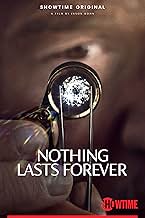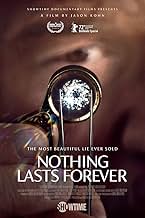Ajouter une intrigue dans votre langueIllusions and reality merge, where authenticity and imagination overlap, and questions arise about the value we place on the goods around us.Illusions and reality merge, where authenticity and imagination overlap, and questions arise about the value we place on the goods around us.Illusions and reality merge, where authenticity and imagination overlap, and questions arise about the value we place on the goods around us.
- Prix
- 3 victoires et 4 nominations au total
Histoire
Le saviez-vous
- ConnexionsFeatures Les hommes préfèrent les blondes (1953)
Commentaire en vedette
This is worth the 90 minutes runtime, which peels back the veneer of the diamond business - more accurately a cartel. Anyone who is skeptical of large corporations was probably already skeptical of the myriad ad campaigns surrounding the diamond industry. And while the documentary seems to focus more on engagement rings, the whole industry seems tainted.
Two people interviewed stand out in this documentary. First is jewelry designer Aja Raden, who is not shy about ripping the lid off the rather secretive diamond cartel, especially De Beers. Raden paints De Beers as a monopolistic organization that controls the supply - and therefore pricing - of a significant percentage of the world's gemstones. And when it is uncovered that some - or maybe a lot - of diamonds on the market may actually be synthetic (not natural), DeBeers comes off almost like a criminal organization. If they know about the synthetic diamonds (those that are "grown" in a lab), which are much less valuable than natural diamonds, then they are operating a fraudulent business. But De Beers will never admit that. Instead, they will continue to try to convince you that an engagement ring is worth the 2 months salary (or maybe 3 to 4 months) that the price commands. Who else does that?
The other interviewee is Martin Rapaport, an industry insider (CEO of Rapaport Group) and easily the ***worst*** salesman on why we should buy diamonds. His arguments are old-school misogyny, mainly focused on diamond engagement rings and how they make "women feel valued." His opinions totally ignore other retail channels for diamond, including earrings, bracelets, necklaces, watches, etc. And eh remains completely dismissive of synthetic diamonds, which obviously threaten his bottomline. Instead of finding a way to help the industry pivot, he remains an obstructionist.
Even De Beers only recently began selling their own line of synthetic diamonds, but still disses their worth. Not unlike the Koch Brothers or ExxonMobil dissing electric cars.
So why not 10 stars? The documentary ends on an unresolved note regarding a gemologist attempting to create the "perfect synthetic", something that no "expert" will ever be able to detect (despite millions of synthetics already in the market and undetected by these same "experts"). I wish the documentary had reached a more concrete conclusion.
Two people interviewed stand out in this documentary. First is jewelry designer Aja Raden, who is not shy about ripping the lid off the rather secretive diamond cartel, especially De Beers. Raden paints De Beers as a monopolistic organization that controls the supply - and therefore pricing - of a significant percentage of the world's gemstones. And when it is uncovered that some - or maybe a lot - of diamonds on the market may actually be synthetic (not natural), DeBeers comes off almost like a criminal organization. If they know about the synthetic diamonds (those that are "grown" in a lab), which are much less valuable than natural diamonds, then they are operating a fraudulent business. But De Beers will never admit that. Instead, they will continue to try to convince you that an engagement ring is worth the 2 months salary (or maybe 3 to 4 months) that the price commands. Who else does that?
The other interviewee is Martin Rapaport, an industry insider (CEO of Rapaport Group) and easily the ***worst*** salesman on why we should buy diamonds. His arguments are old-school misogyny, mainly focused on diamond engagement rings and how they make "women feel valued." His opinions totally ignore other retail channels for diamond, including earrings, bracelets, necklaces, watches, etc. And eh remains completely dismissive of synthetic diamonds, which obviously threaten his bottomline. Instead of finding a way to help the industry pivot, he remains an obstructionist.
Even De Beers only recently began selling their own line of synthetic diamonds, but still disses their worth. Not unlike the Koch Brothers or ExxonMobil dissing electric cars.
So why not 10 stars? The documentary ends on an unresolved note regarding a gemologist attempting to create the "perfect synthetic", something that no "expert" will ever be able to detect (despite millions of synthetics already in the market and undetected by these same "experts"). I wish the documentary had reached a more concrete conclusion.
- jp7570
- 23 avr. 2023
- Lien permanent
Meilleurs choix
Connectez-vous pour évaluer et surveiller les recommandations personnalisées
- How long is Nothing Lasts Forever?Propulsé par Alexa
Détails
- Durée1 heure 27 minutes
- Couleur
- Rapport de forme
- 2.35 : 1
Contribuer à cette page
Suggérer une modification ou ajouter du contenu manquant

Lacune principale
By what name was Nothing Lasts Forever (2022) officially released in Canada in English?
Répondre

















